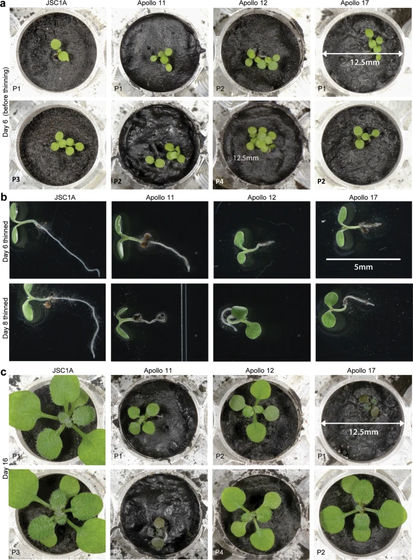Succeeded in germination and growth of plants for the first time with 'soil brought back from the moon'

It was announced that an experiment was conducted to grow plants using the soil of the moon brought back by the Apollo program to see if the plants could grow using local resources in an extraterrestrial environment, and that they succeeded in germination and growth. .. However, it shows a severe form of stress and it is difficult to grow.
Plants grown in Apollo lunar regolith present stress-associated transcriptomes that inform prospects for lunar exploration | Communications Biology

A first: Scientists grow plants in soil from the Moon --UF / IFAS News
Plants will grow in lunar regolith, but they don't like it | Ars Technica
https://arstechnica.com/science/2022/05/plants-can-grow-in-lunar-soil-but-very-poorly/
Cress seeds grown in moon dust raise hopes for lunar crops | Science | The Guardian
https://www.theguardian.com/science/2022/may/12/cress-seeds-grown-in-moon-dust-raise-hopes-for-lunar-crops
A Tale of Moon Dust at the University of Florida --YouTube
When humans live outside the earth in the future, whether plants can be grown on local resources is a big issue.Vegetables are already being cultivated at the International Space Station, and the germination and growth of plants brought from the earth to the surface of the moon have been confirmed, but 'whether plants grow on the soil of the moon' has not been verified.
Cotton germinates in China's lunar explorer, and plants grow for the first time on the moon --GIGAZINE

Professor Anna Lisa Paul and colleagues at the University of Florida have found that the mineralogically the same composition as the sample of the lunar surface (regolith) brought back by Apollo 11, Apollo 12, and Apollo 17 is a simulated substance JSC. We challenged the growth of white-lipped nazuna using 4 types of -1A.
Professor Rob Fel and Professor Anna Lisa Paul involved in the research

UF / IFAS photo by Tyler Jones
As a result, it was confirmed that Arabidopsis germinated in all regoliths. However, their growth was quite different, and Arabidopsis planted in the three lunar regoliths did not grow as well as Arabidopsis planted in JSC-1A. In particular, it can be seen that Arabidopsis thaliana using the Apollo 11 sample is in much worse condition than those of Apollo 12 and Apollo 17.
The image below shows the growth of Arabidopsis thaliana, which were grown in rows from the left end using samples of JSC-1A, Apollo 11, Apollo 12, and Apollo 17.

Arabidopsis thaliana raised on lunar regoliths grew differently, but all showed strong stress.
Professor Paul and colleagues describe the lunar regolith as 'it may be useful for plant production, but things are not very good.' In the future, he concludes that it is necessary to further elucidate the interaction between plants and regolith so that the lunar regolith can be used efficiently.
Related Posts:







